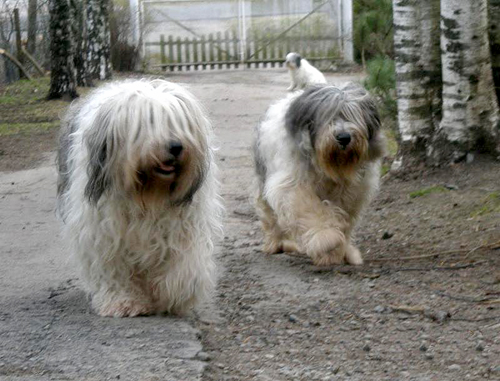|
Medical
lasers are cropping up more and more often in the veterinary
field whether in the vet office itself, as part of
rehabilitation therapy or as an adjunct to chiropractic and
/or acupuncture. They have a wide range of therapeutic
applications although they are most commonly used to relieve
acute or chronic pain, reduce inflammation, and promote
tissue repair and wound healing.
Lasers
stimulate photoreceptors causing cells to absorb energy.
Light in the visible (red) and near infrared wavelengths is
preferentially absorbed into mitochondria – the energy
powerhouses of the cell – as well as the cell membrane.
There it sets off a number of biological reactions –
increasing synthesis of both DNA and RNA (and thereby
proteins), increasing cAMP levels (which is an integral part
of lipid, glycogen and sugar metabolism), increasing
adenosine tri-phosphate (ATP) levels (providing more energy
for cellular activity), increasing synthesis of proteins and
collagen, increasing cell membrane permeability, blood and
lymphatic vessel vasodilation, and cellular proliferation.
This results in a rapid regeneration, normalization, and
healing of damaged cellular tissue. The light triggers the
rearrangement of cellular metabolism and sets off a cascade
of beneficial effects increasing cellular energy and health.
While
therapeutic lasers have been in use for 35 years, until
recently they were generally limited in efficacy. Class III
Low Power Lasers did not generate the longer wavelengths of
light or power output necessary to deeply penetrate tissue
to produce significant results. The need for deeper
penetration with less superficial absorption of laser energy
coupled with the need for higher energy output levels has
led to the development of Class IV, or “high-power”
therapeutic lasers now gaining in popularity since being
approved by the FDA in 2007.
Cells and
tissues that are poorly perfused as a result of
inflammation, edema, and acute or chronic injury have been
shown to have a significantly higher response to laser
therapy irradiation than normal healthy structures. The
delivery of a high amount of laser energy and its ability to
penetrate deep enough to stimulate these target tissues is
the primary reason why Class IV laser therapy has been
associated with much more positive therapeutic outcomes than
the previously available Class III lasers. The introduction
of a significant amount of energy into tissue and articular
structures within a short period of time leads to optimal
cellular stimulation, enhancing wound healing and
penetrating deep within the tissues to encourage healing
within tendons, ligaments, muscles, nerves, layers of the
skin, joints, and even the outer (periosteal) layer of bone.
Circulation to the area increases bringing in more water,
oxygen and nutrients. There is a reduction in inflammation,
muscle spasms, stiffness, and pain.
The biologic
effects of Class IV laser therapy include:
*
Increased Circulation (angiogenesis): vasodilation and the
formation of new capillaries within damaged tissues.
* Immune
Stimulation: increased production of
immunoglobulins(antibodies) and lymphocytes (B and T cells)
and delivery to the area.
*
Reduction of inflammation: improved removal of damaged
cells.
* Pain
relief: stimulate the production of endorphins, the body’s
own natural morphine-like substance which increases the
threshold of pain perception.
*
Accelerated Cell Reproduction and Growth: tendons,
ligaments, bone and muscle heal at an accelerated rate.
*
Stimulation of Nerve Regeneration
*
Increased Cellular Metabolic Activity
*
Reduced Fibrous Tissue Formation: collagen fibers align
themselves in a more linear, uniform, fashion, reducing
scarring and improving the strength of newly healed wounds.
*
Accelerated Wound Healing: Bacterial growth and probably
viral reproduction are inhibited by exposure to laser light,
making laser treatment helpful in treating non-healing
wounds, contaminated wounds and burns.
*
Stimulation of Acupuncture Trigger Points
When
treating acute injuries, the aggressive application of laser
therapy will speed healing and reduce complications.
Chronic conditions may require frequent (daily) treatment
initially followed by a tapering maintenance schedule.
Complete healing may not always be possible, and for chronic
pain relief the use of laser therapy may replace treatment
with steroidal and nonsteroidal pain medications which can
have serious deleterious effects on organ function when used
chronically. The effect is cumulative however, so that the
interval between treatments can often be extended.
Treatments
are painless, although the animal will experience a warming
sensation. Animals usually relax and may even fall asleep
during sessions. Anxiety and aggression resulting from pain
will be relieved.
Applications
for Class IV Laser Therapy include wound care (surgical
incisions, contaminated wounds and abrasions, burns, chronic
anal sac infection, perianal fistulas), dermatologic
conditions (acral lick dermatitis, pyoderma (hot spots),
allergies, acute and chronic ear infections),
musculoskeletal disorders (degenerative joint disease,
intervertebral disc disease, hip and elbow dysplasia, tendon
and ligament injuries, trauma, fractures, arthritis),
neurologic disorders (peripheral nerve injuries, paralysis,
degenerative myelopathy), gingivitis, ulcerated mucous
membranes, and pain management. It should not be used to
treat animals with cancer as it can promote conditions in
which the cancer could grow or spread, and should not be
used around the eyes.
Laser
therapy can improve the quality of life for animals with
chronic pain, and can give senior pets a new lease on life
and delay euthanasia. They may begin to offer puppy like
behaviors again. It can also be used to treat subtle
lameness for improved performance in working and show dogs.
Reported
success rates seem to be about 90% with the most dramatic
cases going from complete immobility to being able to
function normally and free of pain. In most cases the
first session will tell you whether laser treatment will be
successful in chronic cases, but further improvement is to
be expected with subsequent sessions. Veterinarians using
lasers report finding more and more cases that respond
positively, so the list of uses is constantly expanding. I
also know of some owners who were so impressed with the
difference laser treatment made for their Beardies that they
have sought laser treatment for themselves! |

